Laboratory glove boxes are essential equipment in various scientific and industrial fields where controlled environments are required. These enclosed systems enable researchers to work with delicate materials securely while preserving controlled atmospheric conditions. Depending on the application, different types of glove boxes are used to achieve specific research and manufacturing goals. In this blog, we’ll explore the various types of laboratory glove boxes and their applications.
1. Inert Atmosphere Glove Boxes
Inert atmosphere glove boxes are designed to maintain an oxygen- and moisture-free environment by filling the enclosure with inert gases such as nitrogen, argon, or helium.
Applications:
- Battery Research & Manufacturing: Used to assemble lithium-ion batteries without exposure to oxygen and moisture, preventing unwanted chemical reactions. This ensures improved battery performance, longevity, and reliability.
- Material Science: Helps in handling air-sensitive materials like metal powders, catalysts, and nanoparticles. These materials often degrade or react in the presence of oxygen or humidity, making an inert environment essential for research and development.
- Pharmaceutical & Chemical Synthesis: Protects reactive chemicals from oxidation and hydrolysis, enabling the synthesis of high-purity pharmaceutical compounds and fine chemicals without unwanted side reactions.

2. Isolation (Containment) Glove Boxes
Isolation glove boxes, also known as containment glove boxes, create a secure environment to protect users from hazardous or toxic substances.
Applications:
- Pharmaceutical Industry: Used for compounding drugs, handling potent APIs (Active Pharmaceutical Ingredients), and preventing contamination. Ensures worker safety and maintains regulatory compliance for drug manufacturing.
- Radioactive Material Handling: Essential in nuclear research and medical isotope preparation to protect users from radiation exposure. These glove boxes are designed with lead shielding or other radiation-resistant materials for added protection.
- Biological Research: Prevents the spread of pathogens when working with infectious agents and biohazards. Frequently used in microbiology labs, vaccine production, and biocontainment research facilities.
3. Anaerobic Glove Boxes
Anaerobic glove boxes are specialized units designed to maintain a completely oxygen-free environment for microbiological and biochemical studies.
Applications:
- Microbiology & Biotechnology: Used to culture anaerobic bacteria that cannot survive in oxygen-rich environments. These bacteria play a key role in gut microbiome research, disease studies, and industrial fermentation processes.
- Food & Beverage Research: Helps in studying fermentation processes and food preservation techniques. Ideal for investigating probiotics, fermentation-based food production, and spoilage prevention methods.
- Petrochemical Analysis: Protects hydrocarbon samples from oxidation during analysis. Many petroleum-based compounds are highly reactive to oxygen, and an anaerobic glove box ensures accurate experimental results.
4. Vacuum Glove Boxes
These glove boxes operate under a vacuum, eliminating all atmospheric gases before refilling with the desired gas composition.
Applications:
- Aerospace & Defence: Used in material testing and satellite component preparation to simulate space conditions. This is crucial for testing how materials behave in low-pressure or vacuum environments similar to outer space.
- Electronics & Semiconductor Industry: Helps in processing ultra-sensitive electronic components without contamination. Semiconductor wafers, sensors, and microchips require contamination-free environments to ensure high-quality manufacturing.
- Advanced Material Research: Essential for studying superconductors and nanomaterials in a controlled environment. Many emerging materials require precise atmospheric control to maintain stability and achieve the desired properties.

5. HEPA-Filtered (Cleanroom) Glove Boxes
HEPA-filtered glove boxes are designed to maintain a sterile environment by filtering out particulate contaminants.
Applications:
- Medical & Clinical Research: Used for handling sterile drugs, cell cultures, and tissue engineering. These glove boxes help maintain sterility, preventing cross-contamination during medical research and production.
- Forensic Science: Ensures sample integrity when analysing trace evidence. Protects sensitive forensic samples such as DNA, toxicology specimens, and chemical residues from environmental contamination.
- Pharmaceutical Manufacturing: Helps in producing contamination-free formulations and vaccines. HEPA-filtered environments are critical for ensuring sterility in drug production and complying with regulatory standards.
Choosing the Right Glove Box for Your Needs
Selecting the appropriate glove box depends on the type of materials you are handling, the level of containment required, and the environmental conditions necessary for your work. It’s also important to consider elements like gas purification, the effectiveness of filtration, and available customization features when deciding.
Best Practices for Glove Box Maintenance
Proper maintenance of a glove box ensures its longevity and efficiency. Regularly checking for leaks, replacing worn-out gloves, cleaning filters, and monitoring gas purity levels are essential practices. Maintaining the equipment according to the manufacturer's instructions helps ensure long-term reliability and effectiveness. Additionally, maintaining accurate logs can help identify issues early and prevent costly repairs.
Glove boxes play a crucial role in ensuring safety and maintaining controlled conditions across various industries. Whether you’re working with reactive chemicals, biological specimens, or sensitive electronic components, choosing the right type of glove box can significantly impact the success of your research or manufacturing process. Understanding these different types and their applications helps you make an informed choice for your laboratory needs.
